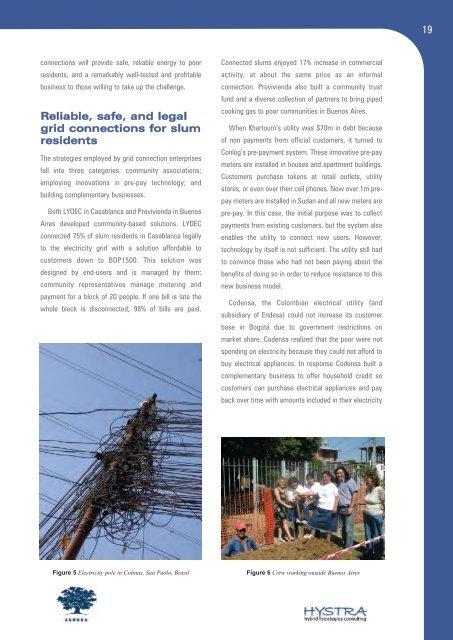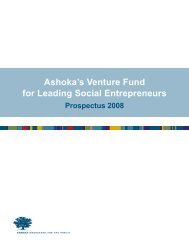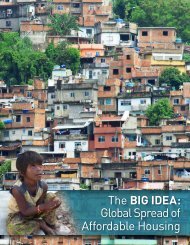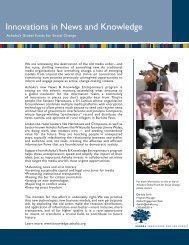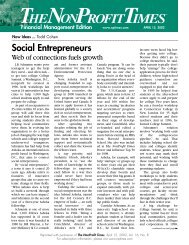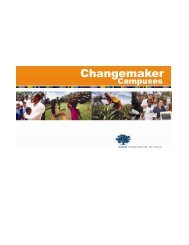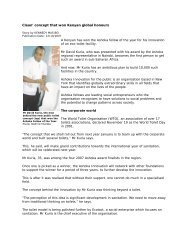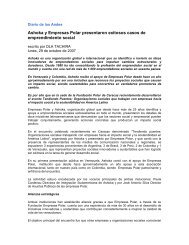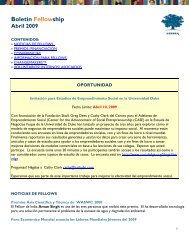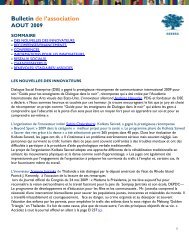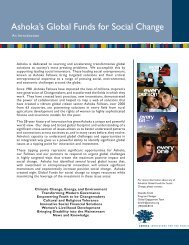Access to Energy for the Base of the - Ashoka
Access to Energy for the Base of the - Ashoka
Access to Energy for the Base of the - Ashoka
You also want an ePaper? Increase the reach of your titles
YUMPU automatically turns print PDFs into web optimized ePapers that Google loves.
connections will provide safe, reliable energy <strong>to</strong> poor<br />
residents, and a remarkably well-tested and pr<strong>of</strong>itable<br />
business <strong>to</strong> those willing <strong>to</strong> take up <strong>the</strong> challenge.<br />
Reliable, safe, and legal<br />
grid connections <strong>for</strong> slum<br />
residents<br />
The strategies employed by grid connection enterprises<br />
fall in<strong>to</strong> three categories: community associations;<br />
employing innovations in pre-pay technology; and<br />
building complementary businesses.<br />
Both LYDEC in Casablanca and Provivienda in Buenos<br />
Aires developed community-based solutions. LYDEC<br />
connected 75% <strong>of</strong> slum residents in Casablanca legally<br />
<strong>to</strong> <strong>the</strong> electricity grid with a solution af<strong>for</strong>dable <strong>to</strong><br />
cus<strong>to</strong>mers down <strong>to</strong> BOP1500. This solution was<br />
designed by end-users and is managed by <strong>the</strong>m:<br />
community representatives manage metering and<br />
payment <strong>for</strong> a block <strong>of</strong> 20 people. If one bill is late <strong>the</strong><br />
whole block is disconnected; 98% <strong>of</strong> bills are paid.<br />
Connected slums enjoyed 17% increase in commercial<br />
activity, at about <strong>the</strong> same price as an in<strong>for</strong>mal<br />
connection. Provivienda also built a community trust<br />
fund and a diverse collection <strong>of</strong> partners <strong>to</strong> bring piped<br />
cooking gas <strong>to</strong> poor communities in Buenos Aires.<br />
When Khar<strong>to</strong>um’s utility was $70m in debt because<br />
<strong>of</strong> non payments from <strong>of</strong>ficial cus<strong>to</strong>mers, it turned <strong>to</strong><br />
Conlog’s pre-payment system. These innovative pre-pay<br />
meters are installed in houses and apartment buildings.<br />
Cus<strong>to</strong>mers purchase <strong>to</strong>kens at retail outlets, utility<br />
s<strong>to</strong>res, or even over <strong>the</strong>ir cell phones. Now over 1m prepay<br />
meters are installed in Sudan and all new meters are<br />
pre-pay. In this case, <strong>the</strong> initial purpose was <strong>to</strong> collect<br />
payments from existing cus<strong>to</strong>mers, but <strong>the</strong> system also<br />
enables <strong>the</strong> utility <strong>to</strong> connect new users. However,<br />
technology by itself is not sufficient. The utility still had<br />
<strong>to</strong> convince those who had not been paying about <strong>the</strong><br />
benefits <strong>of</strong> doing so in order <strong>to</strong> reduce resistance <strong>to</strong> this<br />
new business model.<br />
Codensa, <strong>the</strong> Colombian electrical utility (and<br />
subsidiary <strong>of</strong> Endesa) could not increase its cus<strong>to</strong>mer<br />
base in Bogotá due <strong>to</strong> government restrictions on<br />
market share. Codensa realized that <strong>the</strong> poor were not<br />
spending on electricity because <strong>the</strong>y could not af<strong>for</strong>d <strong>to</strong><br />
buy electrical appliances. In response Codensa built a<br />
complementary business <strong>to</strong> <strong>of</strong>fer household credit so<br />
cus<strong>to</strong>mers can purchase electrical appliances and pay<br />
back over time with amounts included in <strong>the</strong>ir electricity<br />
Figure 5 Electricity pole in Colinas, Sao Paolo, Brazil Figure 6 Crew working outside Buenos Aires<br />
19


